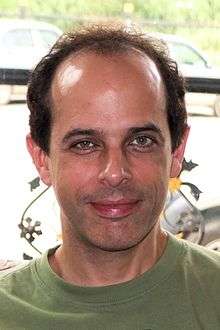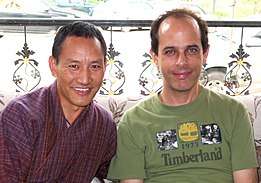David Germano
| David Germano | |
|---|---|
 | |
| Residence | Charlottesville, Virginia |
| Nationality | US |
| Citizenship | United States |
| Alma mater | University of Wisconsin–Madison |
| Known for | Tibetology |
| Scientific career | |
| Institutions | University of Virginia |
| Thesis | Poetic thought, the intelligent Universe, and the mystery self: The Tantric synthesis of rDzogs Chen in fourteenth century Tibet |
David Francis Germano is an American Tibetologist and Professor of Tibetan and Buddhist Studies at the University of Virginia (UVa),[1] the largest Tibetan Studies program in the Americas, where he has taught and researched since 1992. With dual appointments in the School of Nursing and the Department of Religious Studies, Germano currently oversees the work of over twenty graduate students.[2][3] He is on the board of the International Association of Tibetan Studies[4] and is Editor-in-Chief of The Journal of the International Association of Tibetan Studies (JIATS),[5] a leading journal of Tibetology.[6] In 2000, he founded the Tibetan and Himalayan Library, a digital initiative for collaborative building of knowledge on the region, which he continues to lead as Director.[2][7] Since 2008 he has also been the co-director of the UVa Tibet Center.[8] More recently, Germano acted as the founding director of SHANTI (Sciences, Humanities and the Arts Network of Technological Initiatives) at the UVa.[9] Since 2011, Germano has also played a leading role in organizing the University of Virginia's Contemplative Sciences Center, which he currently directs.[10]
Education
He received a Bachelor of Arts (BA) from the University of Notre Dame, and a Doctor of Philosophy (PhD), from University of Wisconsin–Madison, where he focused in Buddhist Studies and Tibetan Studies.[3] He has also spent over a decade living and studying in various parts of Asia, particularly in regions with high concentrations of Tibetans and other Himalayan Buddhists are located - Tibet, China, Bhutan, India, and Nepal.[11]
Research interests
Germano's research interests include philosophical and contemplative traditions in Tibet, particularly Dzogchen in the Nyingma and Bön traditions and Tibetan historical literature. He also researches on the contemporary state of Tibetan religion in relationship to China and non-monastic yogic communities in cultural Tibet.[1][12] He is currently working on a fourfold set of works constituting a comprehensive analysis of the Great Perfection Seminal Heart (rdzogs chen snying thig) tradition from its early formation to its full expression in the fourteenth century within the works of Longchenpa. This will include a deeply annotated translation of one of Longchenpa's major works, The Treasury of Words and Meanings (tshig don mdzod) and detailed studies of the Seminal Heart tradition itself from historical, philosophical, and literary perspectives respectively.[1]
Publications and academic contributions

Germano's academic work primarily focuses around two complementary poles: the contours of Nyingma philosophy, doctrine, and practice (particularly as found in the Dzogs chen school) and how these religious lineages have been interacted with, embodied, and understood throughout Tibetan history. Germano is passionate that contemporary academic work support, benefit, and honor the preservation of Tibetan culture and Tibetan ways-of-life today, giving rise to many of his academic projects.[3] In particular, much of the work David leads at the Tibetan and Himalayan Library has been geared towards not only making academic resources accessible for Tibetans, but also towards mapping and collecting traditional knowledge of Tibetan peoples today. A sampling of the collaborative work Germano leads includes the Tibetan Place Dictionary, the Tibetan Map Collection, and the Tibetan Audio-Video Archive.[3] Beyond these specific projects, Germano organizes several important programs to bring Tibetan thinkers to study in America and facilitate the development of long-lasting academic connections between Tibetan and American scholars, including the University of Virginia Tibetan Entrepreneurs Program and the Education to Employment Initiative.[13]
As part of his interest in supporting contemporary Tibetan peoples, Germano also works to introduce those outside Tibetan cultural areas to the richness and depth of traditional Tibetan culture. He has written numerous encyclopedia articles and annotated textual entries for the Encyclopedia of Religion (Macmillian Reference, 2004) and Religions of Tibet in Practice (Princeton University Press, 1997).[3] He has also been involved with numerous documentary works on traditional Tibetan arts, including the 2004 documentary Tibetan Furniture Making: Traditions and Innovations, produced for the Pacific Asian Art Museum in Los Angeles, CA.[3] In 2014, Germano was the keynote speaker for the Mind and Life Institute conference "Contemplation in Contexts: Tibetan Buddhist Meditation Across the Boundaries of the Humanities and Sciences."[14] Recently, Germano's work as Director of the Contemplative Sciences Center has allowed him to coordinate the interests of numerous innovators, researchers, and scholars to investigate the benefits of contemplative activities.[15] In this context, he has led a larger effort to think about the nature and future of a large public research university in the context of the transformative possibilities offered by contemplative practices, ideas, and values.[15] Germano has also used this position to bring an increasing academic rigor as well as an acknowledgment of the foundational importance of culture to discussions of meditation and contemplation.[15]
Beyond these innovative contributions to academic scholarship and public knowledge, Germano has also edited two volumes and written several articles published in both online and print academic journals.[3] These works continue to explore how Tibetans have practiced and understood Dzogs chen philosophy and cultural identity both throughout history and today.
Edited books
- Germano, David; Trainor, Kevin, eds. (2004). Embodying the Dharma: Buddhist Relic Veneration in Asia. Albany: SUNY Press. ISBN 0791462188.
- Germano, David; Eimer, Helmut, eds. (2002). The Many Canons of Tibetan Buddhism. Brill's Tibetan Studies Library. The International Association for Tibetan Studies Seminar: 2000 Leiden. Leiden: Brill. ISBN 9004125957.
Web
- Germano, David F.; Ryavec, Karl (eds.). "Tibetan and Himalayan Historical and Cultural Geography". Tibetan and Himalayan Library. University of Virginia.
- Germano, David F. (ed.). "Tibetan Literary Collections:Tibetan Literary Encyclopedia". Tibetan and Himalayan Library. University of Virginia.
- Germano, David F.; Weinberger, Steven (eds.). "Tibetan Historical Dictionary". Tibetan and Himalayan Library. University of Virginia.
- David Germano, Nicolas Tournadre: THDL Simplified Phonetic Transcription of Standard Tibetan (Tibetan and Himalayan Digital Library, December 12, 2003)
Articles
- (2007) “Re-membering the Dismembered Body of Tibet: Contemporary Tibetan Visionary Movements in the People’s Republic of China.” An abridged version published in Defining Buddhisms: A Reader edited by Karen Derris and Natalie Gummer in the series “Critical Categories in the Study of Religion,” edited by Russell T. McCutcheon for Equinox Publishing.
- Germano, David (2007). "The shifting terrain of the tantric bodies of Buddhas and Buddhists from an Atiyoga perspective". In Prats, Ramon. The Pandita and the Siddha: Tibetan Studies in Honour of E. Gene Smith. Amnye Machen Institute. External link in
|chapter=(help) - Germano, David F.; Waldron, William S. (2006). "A Comparison of Alaya-vijñāna in Yogacara and Dzogchen". In Nauriyal, D. K.; Drummond, Michael S.; Lal, Y. B. Buddhist Thought and Applied Psychological Research: Transcending the boundaries (PDF). Abingdon, Oxon.: Routledge. pp. 36–68. ISBN 0415374316.
- (2006) with William S. Waldron. “The Arising of Alaya: History and Doctrine.” In The Buddha’s Way: The Confluence of Buddhist Thought and Contemporary Psychology in the Post-Modern Age, editor D. K. Nauriyal, Routledge Curzon Press.
- Germano, David (2005). "Three Decades and Eighteen PhDs: The Tibetan and Buddhist Studies Legacy of Jeffrey Hopkins at the University of Virginia". Tibetan and Himalayan Library.
- (2005) “Atiyoga/Great Perfection”. In Encyclopedia of Religions, Macmillan Reference USA.
- (2005) with Gregory Hillis, “Tibetan Buddhist Meditation”. In Encyclopedia of Religions, Macmillan Reference USA.
- (2005) with Gregory Hillis, “Klong chen rab ‘byams pa”. In Encyclopedia of Religions, Macmillan Reference USA.
- (2005) “The History of Funerary rDzogs chen”. In the Journal of the International Association of Tibetan Studies, vol. 1 , www.jiats.org.
- (2004) with Eveline Yang and others, “Tibetan Furniture Making: Traditions and Innovations”: a documentary produced and exhibited at the “Wooden Wonders” exhibition, Pacific Asian Art Museum in Los Angeles, November 2004.
- (2004) “Relics of the Living Buddha in Tibet”. In Embodying the Dharma: Buddhist Relic Veneration in Asia, editors David Germano and Kevin Trainor, SUNY.
- Germano, David F. (2003). "A Brief Survey of Issues Relating to Tibetan Language in the 21st Century" (PDF). Congressional Executive Commission on China. CECC.
- (2002) “The Tibetan and Himalayan Digital Library”. In the “In Brief” column of D-Lib Magazine (May 2002, www.dlib.org). Republished in ACCESS (www.igroupnet.com).
- (2002) “The Seven Descents and the Nature of sNga’ ‘gyur: The “history” of rNying ma tantras”. In The Many Canons of Tibetan Buddhism, Brill Press.
- (2001) with Nathaniel Garson. “The Rise of “Thematic Research Collections” in the study, teaching and transmission of Buddhist scriptures”. Journal of Electronic Buddhist Texts, Volume 3, December 2001, pp. 147-190. Published by Electronic Buddhist Text Institute, Seoul, Korea.
- (2001) “Encountering Tibet: The Ethics, Soteriology and Creativity of Cross-cultural Interpretation”. In the Journal of the American Academy of Religions.
- (2000) with Janet Gyatso “Longchenpa and the Possessions of Dakinis”. Tantra in Practice, edited by David White, Princeton University Press.
- (1998) “Re-membering the dismembered body of Tibet: The contemporary Ter movement in the PRC”. In Buddhism in Contemporary Tibet: Religious Revival and Cultural Identity (editors Melvyn Goldstein and Matthew Kapstein); Berkeley, California: University of California Press.
- (1997) “Dying, death and other opportunities”. In Religions of Tibet in Practice (editor Donald Lopez), pp. 458-493; Princeton, New Jersey: Princeton University Press.
- (1997) “Food, clothes, dreams and karmic propensities” In Religions of Tibet in Practice (editor Donald Lopez), pp. 293-312; Princeton, New Jersey: Princeton University Press.
- (1997) “Preliminary practices: craziness, the elements and the letter Hum”. In Religions of Tibet in Practice (editor Donald Lopez), pp. 313-334; Princeton, New Jersey: Princeton University Press.
- (1994) “Architecture and Absence in the Secret Tantric History of rDzogs Chen”. In The Journal of the International Association of Buddhist Studies, vol. 17.2, pp. 203-335.
References
- 1 2 3 "David Germano". UVa Religious Studies. UVa. Retrieved 25 July 2014.
- 1 2 "David Germano". Contemplative Sciences Center. UVa. Retrieved 25 July 2014.
- 1 2 3 4 5 6 7 "David F. Germano C.V." (PDF). University of Virginia. 2013.
- ↑ http://www.iats.info/people/
- ↑ "The Journal of the International Association of Tibetan Studies", Tibetan and Himalayan Library, The International Association of Tibetan Studies (7), August 2013, ISSN 1550-6363, retrieved 7 August 2014
- ↑ "Tibetan Studies:". Columbia University Libraries Information Services. Columbia University. Retrieved 7 August 2014.
- ↑ DeCaroli, Robert (August 2003). "Tibetan and Himalayan Digital Library". World History Sources. Roy Rosenzweig Center for History and New Media, George Mason University,. Retrieved 2014-08-13.
- ↑ "David Germano". UVa Tibet Center. UVa. Retrieved 25 July 2014.
- ↑ "SHANTI". Sciences, Humanities and the Arts Network of Technological Initiatives. University of Virginia.
- ↑ http://uvacontemplation.org/content/david-germano
- ↑ "Living Relics of the Buddha(s) in Tibet," Germano, David. Embodying the Dharma: Buddhist Relic Veneration in Asia. Edited by David Germano and Kevin Trainor. Albany: State University of New York, 2004. 51-92.
- ↑ "Erseh Project Groups:Participants Bios" (PDF). India China Institute. New York: The New School. p. 8. Retrieved 4 August 2014.
- ↑ http://www.uvatibetcenter.org/
- ↑ https://www.youtube.com/watch?v=QEciEIaAUMM
- 1 2 3 http://uvacontemplation.org/
External links
- "David F. Germano C.V." (PDF). Institute of World Languages. UVa. Retrieved September 24, 2017.
- Powers, Tashi Grady. "Interview with David Germano". Enlightening Times. Retrieved 4 August 2014.